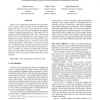Free Online Productivity Tools
i2Speak
i2Symbol
i2OCR
iTex2Img
iWeb2Print
iWeb2Shot
i2Type
iPdf2Split
iPdf2Merge
i2Bopomofo
i2Arabic
i2Style
i2Image
i2PDF
iLatex2Rtf
Sci2ools
CSMR
2008
IEEE
2008
IEEE
How Lisp Systems Look Different
Many reverse engineering approaches have been developed to analyze software systems written in different languages like C/C++ or Java. These approaches typically rely on a meta-model, that is either specific for the language at hand or language independent (e.g. UML). However, one language that was hardly addressed is Lisp. While at first sight it can be accommodated by current language independent meta-models, Lisp has some unique features (e.g. macros, CLOS entities) that are crucial for reverse engineering Lisp systems. In this paper we propose a suite of new visualizations that reveal the special traits of the Lisp language and thus help in understanding complex Lisp systems. To validate our approach we apply them on several large Lisp case studies, and summarize our experience in terms of a series of recurring visual patterns that we have detected.
| Added | 29 May 2010 |
| Updated | 29 May 2010 |
| Type | Conference |
| Year | 2008 |
| Where | CSMR |
| Authors | Adrian Dozsa, Tudor Gîrba, Radu Marinescu |
Comments (0)

